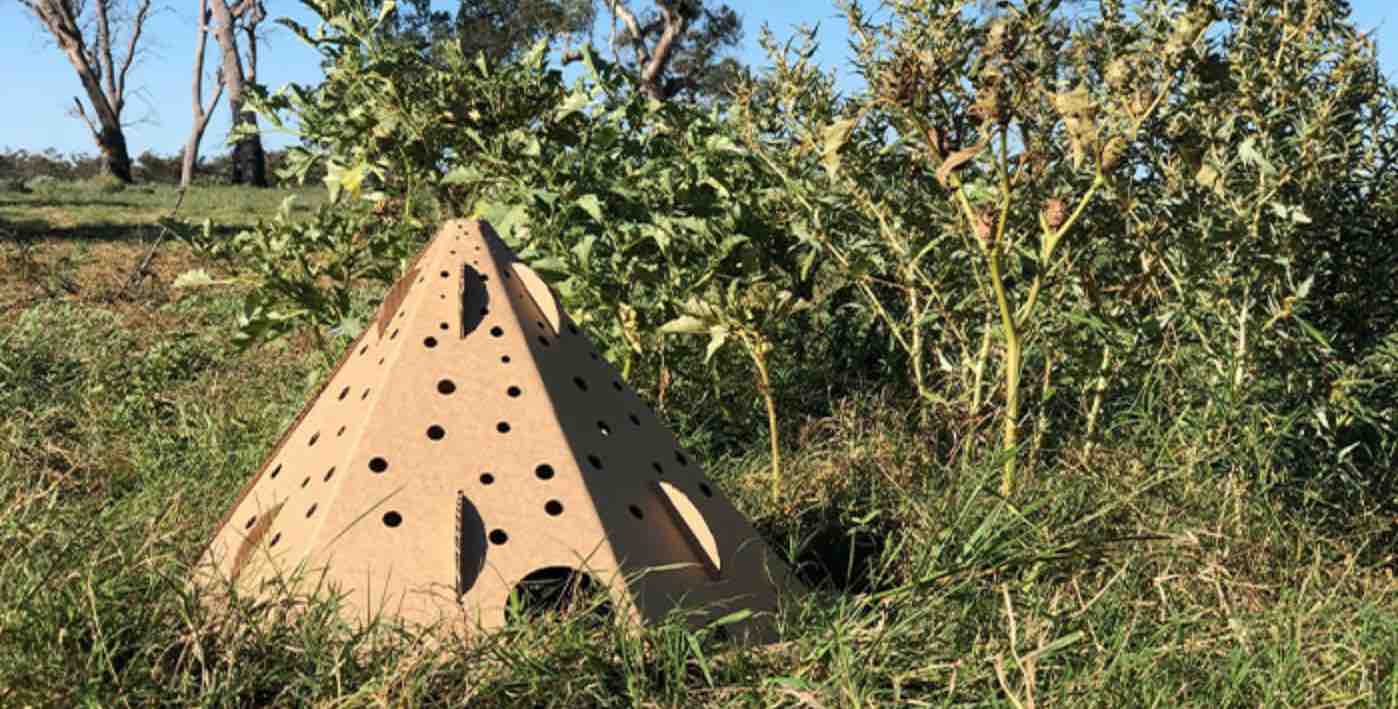New habitat pods developed by an Australian University scientist might be the salvation of small animals trying to survive after wildfires sweep through.

Macquarie University’s Dr. Alexandra Carthey developed the biodegradable wildlife shelters after seeing bushland ravaged by fire and hearing that more animals might die from predators in the post-fire period than during the burn itself.
Her habitat pods have been designed as a safe house for fauna such as bandicoots, possums, antechinus, bush rats and reptiles—ground-dwellers, that she felt, were missing life-saving refuge.
The cardboard shelters are six-sided pyramids, 24 inches wide on each side and 24 inches tall (60cm). They come in easy-to-assemble flat packs.
The pod’s internal structure is three triangles that intersect at a central axis, creating a kind of honeycombed space big enough for the larger animals and providing nooks and crannies for smaller creatures and invertebrates such as beetles, native cockroaches and lizards.
The holes—150 per pod—are also there to let light in, to help vegetation regenerate and eventually take over the site, leaving the pods to biodegrade in situ.
The pods can be anchored with rocks, sandbags or wooden stakes by using a “skirt” of cardboard around the base.
POPULAR: Heroic Dog Gets Award for Saving Over 100 Koalas From Australia’s Bushfires
Carthey has long had a fascination for the dynamics between wild predators and their prey. Seeing vulnerable, exposed wildlife being picked off by hordes of predators after the Black Summer bushfires in 2019 was a call to action.
Guests checking in to the habitat pods
Most tiny creatures will die by predation rather than old age, she maintains. “A lot of their life is about trying not to get eaten.

“They are hardwired to seek the safety of cover. And if you provide it, they will find it. After a bushfire, the thick grasses, leafy bushes, dropped bark, and leaf litter that small critters normally hide under have been burnt away. For the predator, it’s like suddenly spotting your prey across a mown grass lawn.”
And, cats and foxes are known to kill more prey than they can eat, she says. “For 10 bandicoots killed, for example, they might eat only one.
The need for cover is not a new idea, of course. “Chicken wire tunnels, sawn logs and piles of burnt logs have been used in the past. But most solutions involve dragging heavy things around, damaging fire grounds and preventing bush regeneration.”
“It’s not anticipated that the animals will seek cover and hide until the coast is clear,” says Carthey. “We suspect the animals will use the pods more as an escape hatch, that they will run in and out the other side and into another pod, using the network of cover to thwart the predator.
“The pods will be obstacles that block the predator’s line of vision and slows them down – giving the prey a better chance of getting away.”
RELATED: After Massive Wildfires, DroneSeed is Replanting Forests 6x Faster By Using Special Drones
Know when to fold ’em
The flat-pack project has evolved in collaboration with the Australian Wildlife Conservancy and NSW National Parks and Wildlife Service.
The key merit of the habitat pods, says Carthey, is their biodegradability, the idea that they are only there for as long as needed.
North Head Sanctuary in Manly where, in October last year, a hazard reduction burn destroyed 62 hectares of bushland, was the location for the first field trial.
The headland is also the site of a mammal reintroduction program run by Australian Wildlife Conservancy. Three small mammal species, which were locally extinct and have been restored since 2017, are likely contenders to benefit from the shelters.
Some 200 habitat pods will be deployed there. A further 100 will be used in a field trial in the Marramarra National Park, led by a student of Carthey’s, comparing the effectiveness of the pods in recently burnt areas with nearby unburnt areas.
LOOK: Australian Firefighters Pose With Adorable Rescued Wild Animals for Sizzling Charity Calendar
Remote sensing wildlife cameras, triggered by motion and heat, will capture the comings and goings. Surveys of both the pods and vegetation regrowth will be assessed monthly during what is expected to be a 12-month project.
“Pods like these have a huge potential to make a difference,” says the research fellow in the Department of Biological Sciences.
SHARE the Lifesaving Idea to Animal Lovers on Social Media…




















